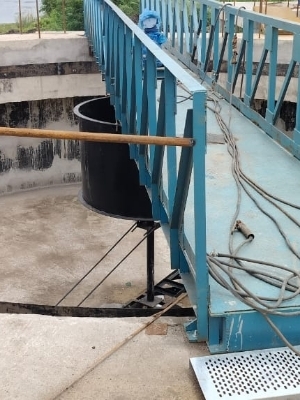Clarifier Mechanism
350000.0 आईएनआर
उत्पाद विवरण:
- फ़ीचर Corrosion & abrasion resistant, Easy maintenance, High load capacity
- वाटर आउट कंडक्टिविटी < 100 µS/cm
- दक्षता (%) Up to 98%
- पंप का प्रकार Submersible/centrifugal pumps
- चालकता में पानी 500-1000 µS/cm
- रीसायकल रेट Up to 95%
- पीएच लेवल 6.5 to 8.5
- अधिक देखने के लिए क्लिक करें
X
मूल्य और मात्रा
उत्पाद की विशेषताएं
- < 70 dB
- 50 Hz
- Lamella, Tube Settler Packs
- Mild Steel, Stainless Steel (SS304/316)
- Surface Scraper/Sludge removal
- Customizable (1 to 500 m3/h)
- 5 to 1000 m3/hr
- Electric
- Clarifier Mechanism
- Water Treatment, Effluent Treatment, Sewage Treatment Plants
- 3-15 kW (depending on capacity)
- 6.5 to 8.5
- Up to 95%
- Up to 99%
- Up to 98%
- 10-1000 m3/day
- Submersible/centrifugal pumps
- 500-1000 µS/cm
- < 100 µS/cm
- 415 V
- Corrosion & abrasion resistant, Easy maintenance, High load capacity
व्यापार सूचना
- प्रति महीने
- महीने
- Yes
- ,
उत्पाद वर्णन
A clarifier is a key component in water and wastewater treatment systems, designed to remove suspended solids and particulate matter through sedimentation. It allows heavier particles to settle at the bottom, forming sludge, while lighter materials (like oils and grease) may rise to the surface for skimming. Types of Clarifiers: 1. Primary Clarifier a Used in wastewater treatment plants to remove large solids before biological treatment. 2. Secondary Clarifier a Used after biological treatment to settle out biomass and suspended solids. 3. Circular Clarifier a Common in large treatment plants, featuring a rotating scraper to collect sludge. 4. Lamella Clarifier a Uses inclined plates to enhance sedimentation efficiency in a compact design. 5. Tube Settler Clarifier a Uses a series of tubes to promote settling in a small footprint. Applications: Municipal wastewater treatment Industrial effluent treatment Drinking water purification Power plants and chemical processing industries Would you like help selecting a clarifier for a specific application?High-Performance Solid-Liquid Separation
Featuring advanced scraper arm drive technology and adjustable overflow, the Clarifier Mechanism effectively separates solids from liquids with efficiency up to 98%. Its consistent performance maintains water quality with output conductivity below 100 S/cm, making it a reliable component in water and wastewater treatment processes.
Customizable and Versatile Design
With diameters ranging from 5 m to 30 m and capacities up to 1,000 m3/day, the clarifier can be tailored to meet project specifications. Options for mild steel or stainless steel ensure durability, corrosion, and abrasion resistance, fitting a wide variety of industrial or municipal applications.
User-Friendly Operation and Maintenance
The clarifier incorporates features for ease of use, including manual or mechanical lifting arrangements and accessible sludge removal mechanisms. Its design minimizes maintenance requirements, enabling trouble-free continuous operation, while the robust structure supports long-term reliability in engineered on-site installations.
FAQs of Clarifier Mechanism:
Q: How does the clarifier mechanism function in wastewater treatment applications?
A: The clarifier mechanism uses a surface scraper arm with a drive system to remove settled sludge from the tank bottom. Water enters through center or peripheral feed, solids settle, and clear water overflows into a peripheral launder, providing effective solid-liquid separation.Q: What types of water sources and treatment applications are suitable for this clarifier?
A: This clarifier is designed for use in industrial and municipal wastewater treatment, including water, effluent, and sewage treatment plants. Its robust construction and customizable design make it suitable for primary and secondary clarification processes.Q: When should the overflow rate and other operating settings be adjusted?
A: Overflow rate and related settings should be adjusted during plant commissioning, routine process optimizations, or when influent water characteristics change. Proper adjustment ensures optimal clarification efficiency and compliance with treatment standards.Q: Where can this clarifier be installed, and what are the installation types supported?
A: The clarifier can be installed on-site or as part of engineered installations in treatment facilities. Available for both new projects and plant upgrades, it accommodates different site requirements and volume capacities.Q: What are the main advantages of using a robust welded MS or SS clarifier mechanism?
A: Using mild steel or stainless steel (SS304/316) ensures high resistance to corrosion and abrasion, extending the equipments lifespan. The structure is engineered for easy maintenance and consistent performance under varying operational loads.Q: How is sludge removed and what is the benefit of a scraper arm with drive?
A: Sludge is removed via a scraper arm, powered either by center or peripheral drive. This mechanism continually collects settled solids, reducing manual intervention, preventing buildup, and ensuring efficient hydraulic operation and cleaner effluent.Q: What level of water purity and efficiency can this clarifier achieve?
A: The clarifier can achieve water purity up to 99% with output conductivity below 100 S/cm. Its overall removal efficiency reaches up to 98%, making it a dependable solution for stringent regulatory and operational requirements.Tell us about your requirement

Price: Â
Quantity
Select Unit
- 50
- 100
- 200
- 250
- 500
- 1000+
Additional detail
मोबाइल number
Email





